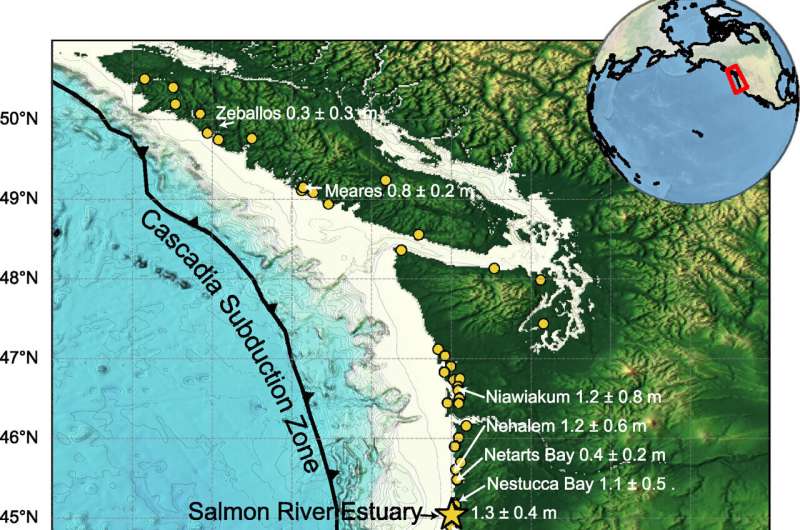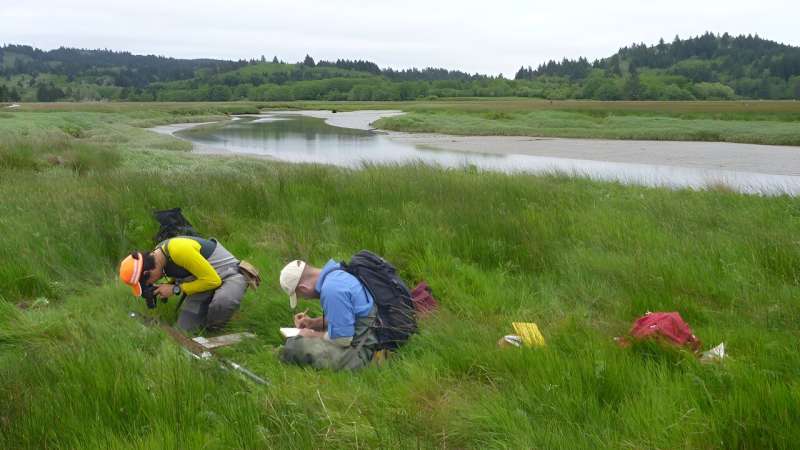This article has been reviewed according to Science X's editorial process and policies. Editors have highlighted the following attributes while ensuring the content's credibility:
fact-checked
proofread
Tsunami sands help scientists assess Cascadia earthquake models

To better understand the scale of past earthquakes and tsunamis, scientists often use earthquake modeling or turn to evidence the tsunamis leave behind, such as sand deposits.
The most recent great earthquake in the Cascadia Subduction Zone, which includes the Pacific Northwest coast, is the focus of many studies because geologic evidence of the event is found from Northern California to Vancouver Island, and observations of the associated tsunami were even recorded in Japan. These observations, combined with computer modeling, have allowed researchers to estimate the quake occurred at 9 p.m. on 26 January 1700.
Multiple studies have collected sediment cores to estimate how much ground subsidence the earthquake caused in coastal wetlands. Studies modeling the 1700 earthquake rely on these subsidence estimates to predict how much the fault slipped. Other studies focus on the extent and thickness of layers of sand and silt washed inland by the tsunami. But no study in Cascadia has yet combined mapping the full extent of these sandy tsunami deposits with a sediment transport model to determine earthquake size.
SeanPaul La Selle and colleagues took 129 cores from marshes in the Salmon River estuary along Oregon's northern coast and combined them with 114 existing core logs to test how well various models of the 1700 Cascadia earthquake performed.

Using the Delft3D-FLOW hydrodynamic and sediment transport model, the authors tested 15 different models of the earthquake to see how well each one reproduced the distribution of sediments brought inland by the tsunami.
They found that to match the thickness and extent of tsunami sediments found in the cores, the earthquake likely would have needed to cause at least 0.8 meters of subsidence at the Salmon River and about 12 meters of slip in the fault. Seven of the earthquake models they tested reproduced these conditions at low tide (when the main Cascadia quake occurred).
The findings are published in the Journal of Geophysical Research: Earth Surface.
The study provides new constraints on the size and character of the 1700 Cascadia earthquake. It also offers new insights into how tsunami deposit mapping and sediment transport models can be used to better reproduce past earthquakes and related tsunamis—and provide insight into future events.
The authors note their models were most sensitive to tide level, sand grain size, and sediment transport coefficients, insights that could help further constrain future models of this and other earthquakes. Further work involving collecting more tsunami deposit data, testing a more extensive set of earthquake sources, and comparing sediment transport and hydrodynamic models could unearth more details.
More information: SeanPaul M. La Selle et al, Testing Megathrust Rupture Models Using Tsunami Deposits, Journal of Geophysical Research: Earth Surface (2024). DOI: 10.1029/2023JF007444
Provided by Eos
This story is republished courtesy of Eos, hosted by the American Geophysical Union. Read the original story here.





















